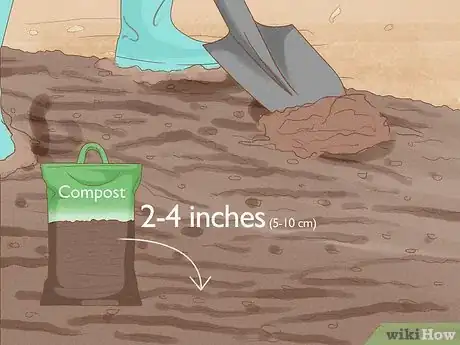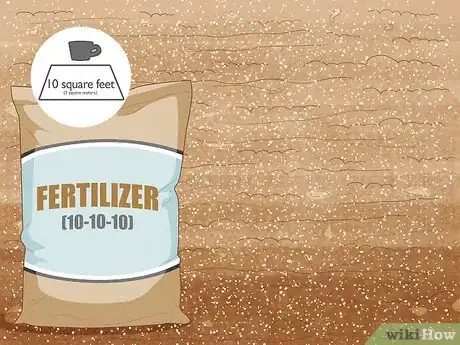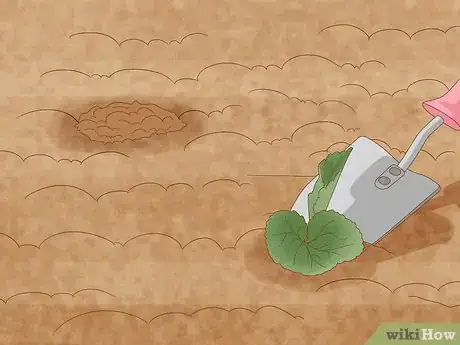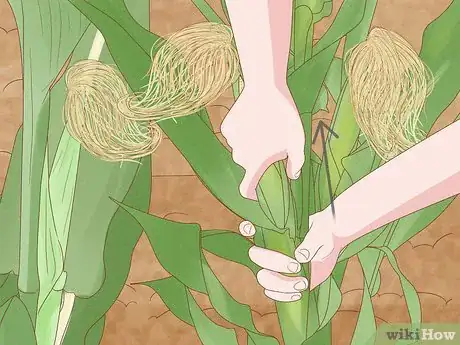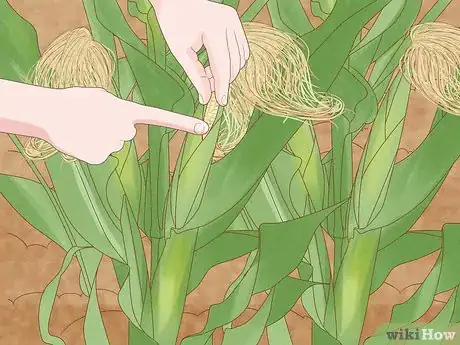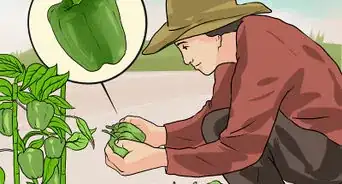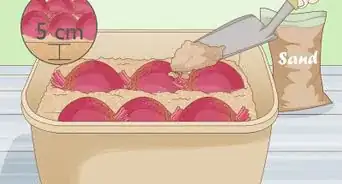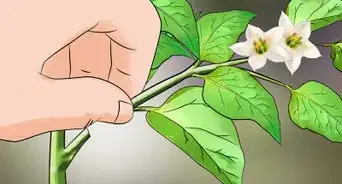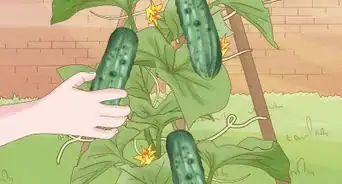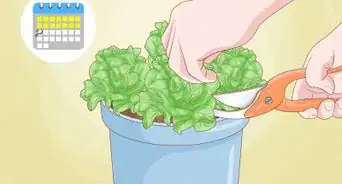This article was co-authored by Katie Gohmann. Katherine Gohmann is a Professional Gardener in Texas. She has been a home gardener and professional gardener since 2008.
wikiHow marks an article as reader-approved once it receives enough positive feedback. In this case, 89% of readers who voted found the article helpful, earning it our reader-approved status.
This article has been viewed 128,639 times.
Sweet corn is an annual crop that is incredibly rewarding to grow and harvest. Because corn is very susceptible to frosts, it’s best grown in the spring in a sunny and wind-protected area. It’s also necessary to regularly water and weed corn, as the crops can suffer if they are deprived of water and soil nutrients. Your efforts in keeping your corn healthy will be rewarded by sweet, juicy corn that is delicious to eat as a snack or side dish, and is far fresher than the ears you can find at the grocery store.
Steps
Planting Sweet Corn
-
1Plant sweet corn two weeks after the last frost date. Because sweet corn is so sensitive to frosts, it’s best to plant it when the danger of severe frosts has passed. Look up the frost dates in your area and plant corn at least two weeks after the last frost of the season is expected to happen.[1]
- The date will vary depending on where you live. If you live in a southern area, you will be able to plant corn earlier than if you live in a more northern area.
- Wait until the soil is above 60 degrees F (15.5 degrees C).
-
2Choose the variety of sweet corn you want to grow. There are many kinds of sweet and super sweet corn, all of which mature at different rates. In general, if you live in a cooler climate, it's best to plant corn varieties that are early bloomers.[2]
- Breeder's Choice is a very common sugar corn that has light yellow kernels that are sweet and creamy. It freezes well and grows in a variety of climates.
- How Sweet Is It is a variety that resists most diseases that affect sweet corn, though it is a late bloomer and grows best in warmer climates.
- Divinity is a white, tender sweet corn that has a high drought tolerance and also resists some diseases.
- Sugar and Gold as well as Butter and Sugar are both early-blooming varieties of corn that do well in cooler climates.
Advertisement -
3Identify the best rectangular area for planting the corn. Corn is a wind-pollinated plant, meaning that the wind blows the pollen from one plant onto another. For this reason, it’s important to plant corn in a block formation rather than long rows, because then the pollen can more easily blow onto the other stalks.
- Find an area to grow the corn that is at least four feet by four feet (1.2 by 1.2 m) and is also in direct sunlight.
- Make sure that you consider the height of the corn compared with your other plants. The corn will cast shade on other plants depending on where you plant it.
-
4Clear the soil of weeds. Before you begin sowing the corn seeds, you should clear the square or rectangular area where you're planting the corn of weeds. Weeds can get in the way of the growth of seedlings, and they also sap the soil of the nutrients that delicate young plants need to grow.
- Clear the entire area that you are using to grow the corn. Pull the weeds up from the roots so that the weeds won’t eventually grow back.
- Also remove any large stones or rocks and break up large clumps of soil.
-
5Add compost to the soil. Before you plant the sweet corn, spread compost over the entire planting area in a layer that is 2-4 inches (5-10 cm) deep. Compost provides nitrogen and other soil nutrients, and also helps the soil to retain moisture.[3]
-
6Use a 10-10-10 fertilizer on the soil. After you lay down the compost, spread a layer of 10-10-10 fertilizer over the mulch, using about 1 cup (236 ml) for every 10 square feet (3 square meters) of corn you are planting.[4]
- The fertilizer will enhance the growth of the corn and give the soil an extra dose of nutrients.
-
7Plant the seeds one and a half inches deep in the soil. After you have cleared the area where you are planting the corn, you can begin sowing the seeds. Plant the corn seeds in the soil in at least four rows that are four feet (1.2 m) long, putting the seeds 1 ½ inches (3.8 cm) deep into the soil. Plant each seed about 9-12 inches (22.8- 30.4 cm) apart from one another.[5]
- When putting the seeds into the ground, use your thumb to make the 1 ½ inch (3.8 cm) hole. Drop in the seed, then brush over some dirt to cover and protect the seed.
- If you want to plant more than four rows, just try to make sure that the plants end up being in a square or rectangular formation, with all the seeds being around 9-12 inches (22.8- 30.4 cm) apart.
- Different varieties of sweet corn mature at different rates. If you want a long harvest season, plant a few varieties of sweet corn.
- If you are planting different varieties of corn, make sure to plant the same varieties in at least two side-by-side rows so that they can pollinate effectively.
- If you can find some pre-started seedlings at your local garden store or nursery, then this is a great option as well.
-
8Water the seeds generously. Directly after you finish planting, generously water the soil until it is rich and dark. Watering the seeds right after you plant them is vital to the corn’s ability to grow and flourish.[6]
Caring For Sweet Corn
-
1Water corn a few days after planting. It’s important to keep your corn properly hydrated when it is first growing. If three or four days after planting there has not been any rain, be sure to water your corn.[7]
- Water it enough so that the soil is dark and moist, but not so much that the water starts to pool.
-
2Water consistently if you live in a dry area. Sweet corn requires about 1 inch (2.5 cm) of water per week as it is starting to grow, so you may need to water your plants if you live in a dry area where you don’t get a lot of rain. To water your corn, use a soaker hose and spray the water as close to the surface of the soil as you can.[8]
- Avoid spraying the tops of the plants, as this can cause the pollen to wash away from the silk of the corn.
- After the corn silks form at the top of the plant, the corn will need one inch (2.5 cm) of water every five days.
-
3Remove weeds from the soil regularly. Whenever you notice new weeds emerging, pull them up by the roots to clear the area. Weeds drain the soil of the nutrients that corn needs to grow. Be careful as you weed to not pull up the shallow roots of the corn plants.
- Corn often grows suckers, or offshoots, which can be easily mistaken for weeds if you do not see that they are attached to the corn plant. While some plants benefit from the removal of suckers, cutting suckers off of corn can actually harm the roots, so it’s best to leave them be.[9]
-
4Use 10-10-10 fertilizer six weeks after planting. After six weeks, the corn should be steadily growing at around 1 ½ feet (45.7 cm) tall, and should have started sprouting tassels. At this point, spread another layer of 10-10-10 fertilizer around the plants, using 1 cup (236 ml) for every 10 feet (3 m) of corn row.[10]
-
5Treat corn silks with an anti-pest solution. Corn is especially susceptible to corn earworms, which develop when earworm moths lay eggs on newly developing corn silks. To prevent these pests from growing in the silks and eating the ears of corn, spray the corn husks every few weeks with a solution made of equal parts vegetable oil and water, with a few drops dishwashing liquid added in.[11]
-
6Protect your corn from animals. Small animals like squirrels, birds and raccoons can also eat your corn. Avoid attracting these animals by clearing out old cornstalks or other decaying plant matter from the garden.
- If you notice raccoons around your corn, consider installing an electric fence around the corn to fend them off. You can also try to plant especially tall varieties of corn so that raccoons cannot access the ears.
Harvesting Sweet Corn
-
1Test the ears for ripeness. Keep an eye on your corn and note the day when you notice the corn silks starting to emerge from the ears. Three weeks after the day that the corn silks appear, start to test the ears for ripeness. To check if the corn is ripe, pull back part of the husk on one ear of corn and pierce a kernel of corn with your fingernail.[12]
- When corn is ripe, thick, milky liquid should spurt from the kernel. If the corn is not yet quite ripe, the liquid will be watery. The milk stage, or prime ripeness stage of corn, usually lasts for about a week.
- You may be able to tell from the husks and silks which corn should be tested. When ears are ready to be picked, the husks of the corn are usually tightly folded and green as opposed to yellowish, and the corn silk is dark brown as opposed to golden.[13]
- If you tested an ear of corn that isn’t ripe, make sure to fold the husk back so that it surrounds the cob again. This will stop pests from accessing the cob.
-
2Snap the ear off by hand. If you tested an ear of corn and it is ready to be picked, hold the stalk with your non-dominant hand, then use your dominant hand to quickly and firmly push down and snap the ear by its base, then twist and pull it away from the stalk. This should leave you with a full ear of unhusked corn, as well as a small amount of the rod-like base from which the corn grew.[14]
-
3Eat the corn directly after picking it. After you pick your corn, it’s best to eat it as soon as possible. You can leave it in the refrigerator for a couple of hours or overnight, but the freshness will be diminished. To have the best tasting corn, remove the husk and silks, wash the corn, then grill it or boil it directly after picking it.[15]
- You can also freeze corn by carving off the kernels from the cob, placing them in airtight bags, and storing them in the freezer. You also may Can Corn by hermetically sealing the corn kernels in canning jars.
-
4Keep checking on the corn every couple days after picking your first ripe ears. After you have removed your first ripe ears of corn, keep checking on the plants. Each cob of the same type of corn should ripen in the same couple of months, and you don’t want to miss any fresh corn!
- If you are growing multiple varieties of corn, keep in mind that they will mature at different rates. Keep tabs on all the varieties of corn you are growing so that you will be able to harvest them at the correct time.
Expert Q&A
Did you know you can get expert answers for this article?
Unlock expert answers by supporting wikiHow
-
QuestionCan I grow corn using sweetcorn seeds from the corn at the grocery store?
 Katie GohmannKatherine Gohmann is a Professional Gardener in Texas. She has been a home gardener and professional gardener since 2008.
Katie GohmannKatherine Gohmann is a Professional Gardener in Texas. She has been a home gardener and professional gardener since 2008.
Professional Gardener Almost all of the corn we eat is hybrid corn (https://www.ars.usda.gov/oc/timeline/corn/). Seeds from a hybrid parent will not grow the same way as the parent, meaning that you could end up with corn that is completely different than the corn you originally bought. You could try drying the cobs and saving the kernels, but in my opinion it's better to purchase seeds that are designed for planting.
Almost all of the corn we eat is hybrid corn (https://www.ars.usda.gov/oc/timeline/corn/). Seeds from a hybrid parent will not grow the same way as the parent, meaning that you could end up with corn that is completely different than the corn you originally bought. You could try drying the cobs and saving the kernels, but in my opinion it's better to purchase seeds that are designed for planting. -
QuestionHow do you plant maize in Kenya?
 Community AnswerPlanting corn in Kenya is much like planting corn in other parts of the world, however, you may want to research and buy corn seeds that produce varieties of corn that thrive in drier climates with more sandy soils.
Community AnswerPlanting corn in Kenya is much like planting corn in other parts of the world, however, you may want to research and buy corn seeds that produce varieties of corn that thrive in drier climates with more sandy soils. -
QuestionCan I soak the seeds before planting?
 Community AnswerYes. Soak them for around 20 hours or until the seed feels softer and looks plump.
Community AnswerYes. Soak them for around 20 hours or until the seed feels softer and looks plump.
Things You'll Need
- Corn seeds
- Compost
- 10-10-10 fertilizer
- vegetable oil
References
- ↑ https://www.southernstates.com/articles/backyard-sweet-corn.aspx
- ↑ https://books.google.com/books?id=lFlANGwPqXAC&pg=PA229&lpg=PA229&dq=butter+and+sugar+corn+climate&source=bl&ots=z86XBVYZdu&sig=SEBrFA3kGEY6Q0fS6_x50nFXGLU&hl=en&sa=X&ved=0ahUKEwjGx93spKzQAhXLKiYKHXFiAKwQ6AEIQTAG#v=onepage&q=butter%20and%20sugar%20corn%20climate&f=false
- ↑ http://homeguides.sfgate.com/prep-soil-planting-corn-69986.html
- ↑ https://bonnieplants.com/growing/growing-corn/
- ↑ https://www.southernstates.com/articles/backyard-sweet-corn.aspx
- ↑ https://www.southernstates.com/articles/backyard-sweet-corn.aspx
- ↑ https://www.southernstates.com/articles/backyard-sweet-corn.aspx
- ↑ https://www.goodhousekeeping.com/home/gardening/a20705742/how-to-grow-corn/
- ↑ https://www.goodhousekeeping.com/home/gardening/a20705742/how-to-grow-corn/
- ↑ https://bonnieplants.com/growing/growing-corn/
- ↑ https://bonnieplants.com/growing/growing-corn/
- ↑ https://www.goodhousekeeping.com/home/gardening/a20705742/how-to-grow-corn/
- ↑ https://www.southernstates.com/articles/backyard-sweet-corn.aspx
- ↑ https://www.southernstates.com/articles/backyard-sweet-corn.aspx
- ↑ https://www.southernstates.com/articles/backyard-sweet-corn.aspx
About This Article
To grow sweet corn, plant sweet corn seeds 2 weeks after the last expected frost. Bury the seeds 1.5 inches below the soil in an open outdoor space that's free of weeds. Add compost and fertilizer to the soil to help your sweet corn grow healthy and strong. Generously water the seeds right after you plant them, and after that give them 1 inch of water per week. Routinely pull weeds and check for pests and soon you'll have delicious sweet corn to harvest! For more tips from our Horticulturist reviewer, including how to harvest your sweet corn, read on!




